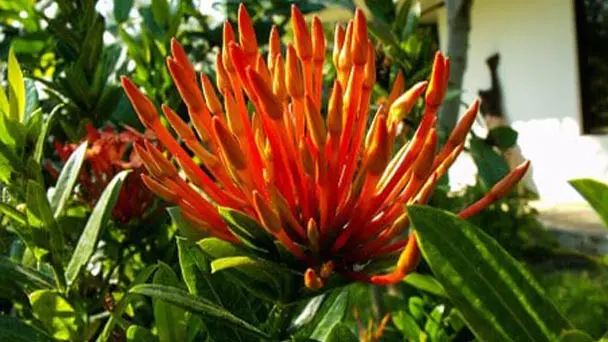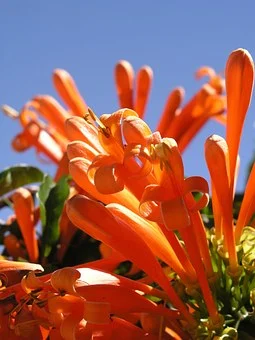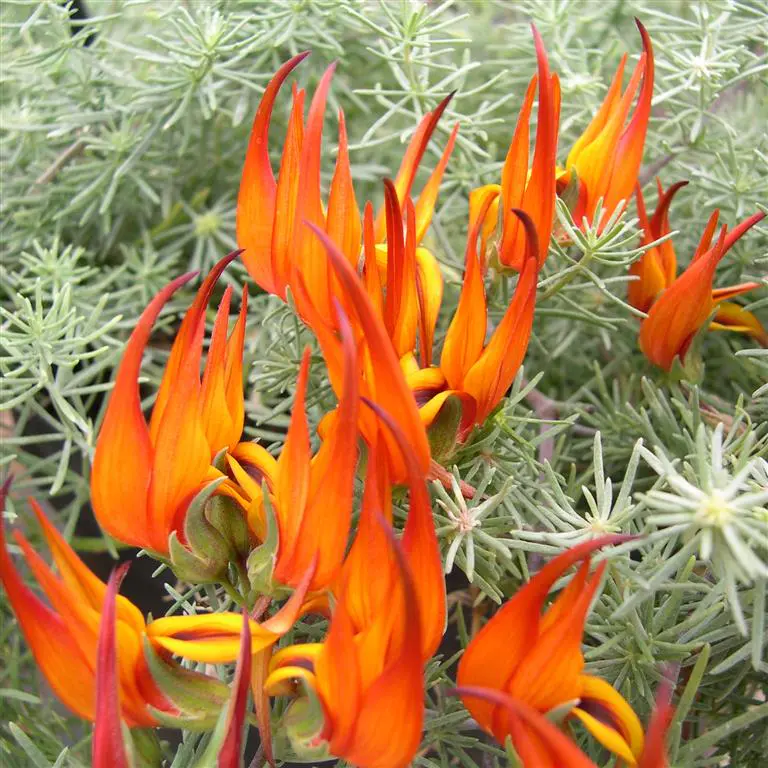How to Grow and Care for Pyrostegia Venusta (Fire Vine)
Written by Ivy
Nov 11 2021

The vitality of Pyrostegia Venusta (Fire Vine) is very tenacious. Pyrostegia vines can grow very long, and there are many tendrils on it. It is usually planted on the fence of the yard or climb along the wall. At the flowering stage of Pyrostegia Venusta, the red flowers are like strings of firecrackers, which are very eye-catching. Many people think that the red flowers of Pyrostegia Venusta can give people a very festive feeling and have a very good meaning, so now more and more people are willing to raise one or two Pyrostegias at home.

At what time Pyrostegia Venusta needs watering, not what we has the final say, but depends on the growth of the flower of the firecracker. In the high temperature season, we really need to often water it, and even spray water on the branches and leaves of Pyrostegia to make the plant grow healthily. However, in autumn, Pyrostegia begins to germinate a large number of flower buds. At this time, we should appropriately reduce the number of watering, which is conducive to the formation of flower buds and open more flowers. When the temperature is very low in winter, we should also reduce the number of watering. If we water in winter, we'd better not water at night, but at noon, so as to achieve the best effect. As long as we properly water the Pyrostegia, the branches and leaves of the Pyrostegia will remain green.
When we conserve firecracker flower, in order to make its ornamental value higher, we will conduct regular Pyrostegia pruning to cut off its sick branches and thin branches, which can greatly reduce the nutrient consumption of Pyrostegia, accumulate more nutrients to germinate new branches and make it produce more flowers. (Find more Climbing Plants with Flowers here.)
Control method: when dealing with this Pyrostegia pest disease, if the number of pests is relatively small, we can trim off the damaged branches and then disinfect the plants. If the quantity is large, we can directly use 3000 times of 50% Pirimicarb wettable powder to spray directly.
Control method: we can use 1000-1500 times of insecticide mixed with 40.7% lesbon EC and 80% dichlorvos EC in the ratio of 1:1 to spray and kill the pests and diseases of this Pyrostegia pest disease.
Control method: when controlling this Pyrostegia pest, we can use 1000 times of 75% methyl tobuzin wettable powder to spray the diseased plant. Generally, it can be cured by spraying once every 7-10 days and 2-3 times.
Control method: when dealing with this Pyrostegia pest, we can use 20% silazole · prochloraz 1000 times solution to spray it for control. Generally, it is sprayed once a week, and it can be cured after 1-2 times
It is very important to select branches for cutting. Relatively strong branches should be used, and branches affected by diseases and pests should not be used. When I can cut from the mother plant, I need a smooth cut. We need to use more breathable soil when propagating Pyrostegia plant, and the pH value should be between 6.5 and 7.5. River sand, perlite and some vermiculite can be mixed for use, and remember to disinfect before Pyrostegia Venusta propagation by cuttings. We can use rooting powder for treatment before cutting, and then disinfect and dry for cutting. Then dig a hole in the soil, cut branches into it and slowly pour the soil through.
The stems and leaves of Pyrostegia Venusta plant also have medicinal value, slightly bitter and dry. It also has the effect of clearing heat and benefiting the throat. Usually suffering from tuberculosis or bronchitis, you can pick the stems and leaves of firecracker flowers, wash, dry and pound them into powder, and take them with warm water every day. Similarly, do not exceed 5g.
Read Next:
Top 20 Climbing Plants with Flowers for Your Garden
Pyrostegia Venusta Quick InfoPyrostegia Venusta Care in DetailPyrostegia Venusta WateringPyrostegia Venusta SoilPyrostegia Venusta LightPyrostegia Venusta TemperaturePyrostegia Venusta HumidityPyrostegia Venusta FertilizerPyrostegia Venusta PruningPyrostegia Venusta RepottingPyrostegia Venusta Pest & Disease Control1. Aphids2. Scale insects3. Anthrax4. Leaf spotPyrostegia Venusta PropagationPyrostegia Venusta Propagation from CuttingPropagated by Layering SuckersPyrostegia Venusta Benefits
Pyrostegia Venusta Quick Info
| Botanical/Scientific Name | Pyrostegia Venusta |
| Common Name | Flaming Trumpet,Flame Vine,Fire Vine |
| When to Grow/Bloom/Harvest | Planting in early spring/3-inch long tubular flowers from fall to spring |
| Uses | Treatment of infections of respiratory system like colds, flu and bronchitis |
| Origin | Southern Brazil, Bolivia, northeastern Argentina and Paraguay |
| Light Care | Full sun or light shade |
| Soil Care | Well-drained soil |
| Temperature Care | Temperatures remain above 20 F |
| Humidity Care | Moisture |
| Watering | Water the plant regularly |
| Pruning Care | Pruning as part of flame vine care encourages blooms throughout the plant |
| Fertilizer Care | Fertilize once a month during the flowering period with mineral fertilizer |
| Propagation | Propagated by layering suckers |
| Toxic | Non-toxic |
| Flower Color | Orange |
Pyrostegia Venusta Care in Detail

Pyrostegia Venusta Watering
When watering the pyrostegia Venusta, we should pay attention not to water the flowers. It is best to water it slowly from the base of the plant. Water it every time, but there should be no ponding. Generally, keep wet in spring and replenish water frequently. More water should be sprayed in summer to reduce the temperature. Reduce water volume in autumn and control water at low temperature in winter to avoid frostbite. For the Pyrostegia Venusta that has just been put into the basin, we need to water it to make it serve the basin faster. Just buy more ventilation, the soil is slightly wet, a lot of watering can not be absorbed, but easy to rot roots.At what time Pyrostegia Venusta needs watering, not what we has the final say, but depends on the growth of the flower of the firecracker. In the high temperature season, we really need to often water it, and even spray water on the branches and leaves of Pyrostegia to make the plant grow healthily. However, in autumn, Pyrostegia begins to germinate a large number of flower buds. At this time, we should appropriately reduce the number of watering, which is conducive to the formation of flower buds and open more flowers. When the temperature is very low in winter, we should also reduce the number of watering. If we water in winter, we'd better not water at night, but at noon, so as to achieve the best effect. As long as we properly water the Pyrostegia, the branches and leaves of the Pyrostegia will remain green.
Pyrostegia Venusta Soil
Pyrostegia Venusta does not have strict requirements for soil, but it grows more vigorously in fertile soil rich in organic matter, well drained and deep soil layer. For Pyrostegia culture soil, we should mainly select rotten leaf soil, garden soil and mountain mud, and apply an appropriate amount of rotten compost, bean cake, bone meal and other organic fertilizers as base fertilizer.Pyrostegia Venusta Light
Pyrostegia has high requirements for light. If the light is insufficient, it will have a great impact on its growth. Most Pyrostegias are planted outdoors, on walls and shelves, so the lighting conditions are good. If we plant it in the shade, the Pyrostegia will not grow well.Pyrostegia Venusta Temperature
Pyrostegia is afraid of low temperature. If it is planted outdoors and climbs on the wall or shelf, it can't be moved indoors in winter. In order to avoid its death in winter. In winter, we can use bamboo poles or wooden sticks to build a shelf around the firecracker flowers, which is covered with a layer of thermal insulation film and other things to play a certain role in thermal insulation. When the weather is fine and the temperature is high, we should open the thermal insulation film to give Pyrostegia proper ventilation.Pyrostegia Venusta Humidity
This Climbing Plants with Flower has high requirements for humidity, especially a large amount of water is required to absorb during growth, so we should pay attention to dry and wet during breeding, so as to achieve higher soil humidity. Moreover, Pyrostegia plant also has high requirements for air humidity, so we also need to spray water mist around the potted plants of Pyrostegia Venusta regularly, Generally, water once a day in spring and autumn. In summer, except for cloudy and rainy weather, water the Pyrostegia Venusta twice a day.Pyrostegia Venusta Fertilizer
The flowers of Pyrostegia grow very densely and there are many flowers. If we want to keep the this Climbing Plants with Flower in a long flowering period, we need to apply fertilizer to it in time. Otherwise, relying on the nutrients of the soil alone is far from enough to supply so many flowers, let alone ensure a long flowering period. Therefore, in the process of propagating Pyrostegia, we must fertilize in time. At ordinary times, we can often apply light fertilizer, but there are three periods, we must ensure sufficient nutrients. First, when the seedlings are just planted, we must apply enough base fertilizer so that the Pyrostegia seedlings can grow more healthily. When Pyrostegia germinates flower buds, we must provide sufficient nutrients, so that it can grow more flower buds and open more beautiful flowers. During the flowering period of Pyrostegia Venusta, we should also ensure sufficient nutrient supply, so that the flowers can be larger and the flower color can be more bright.Pyrostegia Venusta Pruning
Pyrostegia Venusta is a perennial evergreen climbing vine, which can grow upward with the help of other things. When the seedlings grow to a certain height, set up a flower rack in the basin, bind the stems and vines to the flower rack, and let them climb up and grow. When the branches grow to a certain height on the attached objects, they need to topple to promote the germination of new branches, so as to benefit the flowering. The branches that have already bloomed will not bloom in the coming year, but the newly grown branches should be pregnant with buds. Therefore, Pyrostegia pruning should be carried out in time for some old branches and weak branches, so as not to consume nutrients and affect the flowering of the next year.When we conserve firecracker flower, in order to make its ornamental value higher, we will conduct regular Pyrostegia pruning to cut off its sick branches and thin branches, which can greatly reduce the nutrient consumption of Pyrostegia, accumulate more nutrients to germinate new branches and make it produce more flowers. (Find more Climbing Plants with Flowers here.)
Pyrostegia Venusta Repotting
Pyrostegia plant has blooming and falling flowers, withered branches, vigorous metabolism and large nutrient consumption. It needs to change pots and soil every year to ensure that flowers and leaves flourish. If possible, we'd better open the bottom of the basin and put it on the porcelain flower rack filled with flower mud, so that the root system can go directly to the flower rack and directly into the ground, so as to avoid Pyrostegia repotting and keep the flowers and leaves forever. In addition, we should always straighten out the branches to ensure shape.
Pyrostegia Venusta Pest & Disease Control
1. Aphids
This kind of insect is a kind of insect pest existing in many plants, and Pyrostegia Venusta is no exception. It is a plant feeding insect, which mainly endangers the leaves and stems of Pyrostegia. It will gradually absorb the juice, resulting in a large loss of plant nutrients. With the passage of time, it will also lead to the gradual withering and death of plants.Control method: when dealing with this Pyrostegia pest disease, if the number of pests is relatively small, we can trim off the damaged branches and then disinfect the plants. If the quantity is large, we can directly use 3000 times of 50% Pirimicarb wettable powder to spray directly.
2. Scale insects
Scale beetle is a very harmful pest, which mainly threatens the leaves, branches and fruits of Pyrostegia. This Pyrostegia Venusta pest disease will cause yellowing of leaves, withering of branches, decline of tree potential and other phenomena on branches, leaves and fruits, as well as coal pollution.Control method: we can use 1000-1500 times of insecticide mixed with 40.7% lesbon EC and 80% dichlorvos EC in the ratio of 1:1 to spray and kill the pests and diseases of this Pyrostegia pest disease.
3. Anthrax
This Pyrostegia pest disease mainly threatens the leaves of Pyrostegia. At the initial stage of onset, many brown spots will appear on the leaves, and the spots will gradually expand over time and occupy the general area of leaflets, making the plants unable to carry out photosynthesis and gradually wither, and the leaves will gradually fall off.Control method: when controlling this Pyrostegia pest, we can use 1000 times of 75% methyl tobuzin wettable powder to spray the diseased plant. Generally, it can be cured by spraying once every 7-10 days and 2-3 times.
4. Leaf spot
This Pyrostegia pest disease is a disease caused by fungi. Its high incidence period is in spring and autumn every day, so we must pay special attention during this period. When this disease occurs, many brown round spots will appear on the leaves of Pyrostegia, and will gradually spread to the petiole and stem over time, resulting in the gradual shrinkage and death of the plant.Control method: when dealing with this Pyrostegia pest, we can use 20% silazole · prochloraz 1000 times solution to spray it for control. Generally, it is sprayed once a week, and it can be cured after 1-2 times
Pyrostegia Venusta Propagation
Pyrostegia Venusta Propagation from Cutting
Because Pyrostegia plant is not easy to get seeds, Pyrostegia Venusta mostly uses cutting propagation to reproduce. Pyrostegia Venusta propagation by cuttings is usually carried out in spring. This is also a common breeding method. If you master the cutting method, the survival rate is also relatively high. The cutting time should be selected, either from May to June in spring and summer or from September to October in autumn. Only by choosing the right time, the probability of branch rooting will be improved.It is very important to select branches for cutting. Relatively strong branches should be used, and branches affected by diseases and pests should not be used. When I can cut from the mother plant, I need a smooth cut. We need to use more breathable soil when propagating Pyrostegia plant, and the pH value should be between 6.5 and 7.5. River sand, perlite and some vermiculite can be mixed for use, and remember to disinfect before Pyrostegia Venusta propagation by cuttings. We can use rooting powder for treatment before cutting, and then disinfect and dry for cutting. Then dig a hole in the soil, cut branches into it and slowly pour the soil through.
Propagated by Layering Suckers
Pyrostegia Venusta can also carry out strip propagation, which is mainly carried out in spring and summer. We can bury the longer branches of Pyrostegia into the soil, remove a circle of bark to facilitate rooting, and generally grow new roots in about a month. The branches with roots can be cut off and replanted. Pyrostegia can also press the branches directly into the flowerpot. If your Pyrostegia propagated by layering suckers can bloom in the same year.Pyrostegia Venusta Benefits
The flowers of Pyrostegia Venusta are slightly sweet, which can moisten the lungs and stop coughing. Usually, when we catch a cold and get angry, we will cough and dry the lungs. At this time, we can pick the flowers of Pyrostegia Venusta, clean them, dry them in the sun, mash them into powder, and send them with warm boiled water every time, no more than 5g.The stems and leaves of Pyrostegia Venusta plant also have medicinal value, slightly bitter and dry. It also has the effect of clearing heat and benefiting the throat. Usually suffering from tuberculosis or bronchitis, you can pick the stems and leaves of firecracker flowers, wash, dry and pound them into powder, and take them with warm water every day. Similarly, do not exceed 5g.
Read Next:
Top 20 Climbing Plants with Flowers for Your Garden
Latest Updated
- Benefits of Bugleweed - 7 Science-backed Health Benefits
- Bugleweed Dangers & Side Effects - Is It Poisonous?
- How to Plant Evergreen Trees - What You Should Know
- When to Plant Evergreens - Grow Guide for Evergreen Trees
- 12 Wonderful Evergreen Shrubs for Your Garden
- 12 Popular Evergreen Plants with Pictures for Beginners
- When And How To Prune A Lilac Bush Like a Pro
- How to Grow & Care for Lilac Vine (Hardenbergia Violacea)
- Japanese Lilac Tree (Syringa Reticulata) Care & Propagation Guide
- Shumard Oak Pros and Cons - What to Know
Popular Articles
- Winter maintenance of Antirrhinum Majus
- How to Grow Terminalia Mantaly Tree
- How to Grow and Care for Crossostephium Chinense
- How to grow Antirrhinum Majus in spring
- Peristeria Elata (Dove Orchid) Profile: Info & Care Guide
- Underwatered Snake Plant (Sansevieria Trifasciata) - Signs And How To Fix
- How to Care for Brazilian Jasmine Plant (Mandevilla Sanderi)
- How to Grow & Care for Graptopetalum Purple Delight in Summer
- Rosa Chinensis (China Rose): Plant Growing & Care Tips
- How to Care for Baby Sun Rose (Aptenia Cordifolia)